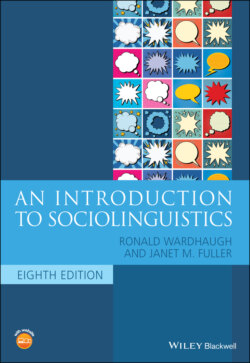Читать книгу An Introduction to Sociolinguistics - Ronald Wardhaugh, Janet M. Fuller - Страница 57
Features of AAVE
ОглавлениеThe features of AAVE which have been researched include phonological, morphological, and syntactic characteristics (see also chapter 5 on variationist studies for discussions of research on this topic). We will focus here primarily on features which have been found to be specific to AAVE and which have been researched extensively over several decades. This is not, we stress, an exhaustive list of features nor an in‐depth coverage of the research on their variation (please see the references in the Further Reading section to find more research on this topic). The aim of this section is to make our readers aware of some of the structural characteristics of this dialect.
On the phonological level, consonant cluster reduction has often been noted (e.g., from Labov 1972 to Wolfram and Thomas 2008); words such as test, desk, and end may be pronounced without their final consonants. Other phonological features commonly found in varieties of AAVE include r‐lessness and /ai/ monophthongization, and realization of ‘th’ sounds as /t/, /d/, /f/, /v/ or /s/ (Thomas 2007), although these features are found in other varieties of English in North America and around the world.
Some of the most salient and frequently researched features of AAVE have to do with verbal ‐s marking. This involves the presence or absence of the suffix ‐s on finite verbs. In Standard English dialects, ‐s marking is only on third‐person singular verbs (e.g., She likes cheese). In AAVE, this marking is sometimes absent (e.g., She like school) and this is considered one of the core features of AAVE. Further, verbal ‐s marking also appears in grammatical contexts other than third‐person singular (e.g., The men has wives) in some varieties of AAVE. There is extensive literature on patterns of ‐s marking on verbs (Cukor‐Avila 1997; Montgomery et al. 1993; Montgomery and Fuller 1996; Poplack and Tagliamonte 1989, 1991, 2005; Rupp and Britain 2019) showing similarities to other nonstandardized English dialects.
Another interesting pattern in the verbal system of AAVE is the use of the zero copula. As Labov (1969) has explained, the rule for its use is really quite simple. If you can contract be in Standard English, you can delete it in AAVE. That is, since ‘He is nice’ can be contracted to ‘He’s nice’ in Standard English, it can become ‘He nice’ in AAVE. However, ‘I don’t know where he is’ cannot be contracted to ‘I don’t know where he’s’ in Standard English. Consequently, it cannot become ‘I don’t know where he’ in AAVE. We should note that the zero copula is very rarely found in other dialects of English. It is also not categorical in AAVE; that is, there is variation between realization of copula forms and zero copula. Labov (1972) argued for the use of zero copula as a marker of group membership among certain Black youths in Harlem, members of a gang called the Jets. Zero copula use diminished as strength of group membership decreased. There is a wealth of literature on the linguistic factors in copula variation in AAVE (see, for example, Blake 1997; Hazen 2002; Rickford et al. 1991; Weldon 2003).
Still another feature of AAVE has been called habitual be (also called invariant be, or be2). This feature has become a stereotype of Black speech, often imitated in caricatures of AAVE speakers; for example, the US toy store ‘Toys “R” Us’ has been jokingly called ‘We Be Toys’ in Harlem, a predominantly African American neighborhood of New York City (see the link to a discussion of this joke in the web links provided in the online materials for this textbook). The feature is called ‘invariant’ be because the copula is not conjugated but used in the form of be for all subjects (i.e., I be, you be, he/she/it be, etc.). It is called ‘habitual’ because it marks an action which is done repeatedly, that is, habitually. Thus the utterance They be throwing the ball does not mean that the people in question are (necessarily) currently throwing a ball, but that they often get together and throw a ball back and forth. This differs in meaning from They (are) throwing the ball, which indicates something that is happening at the current time. Research on this feature often focuses on its development, which leads us to another important aspect of research on this dialect as a whole: how did it develop, and how does it continue to change?
